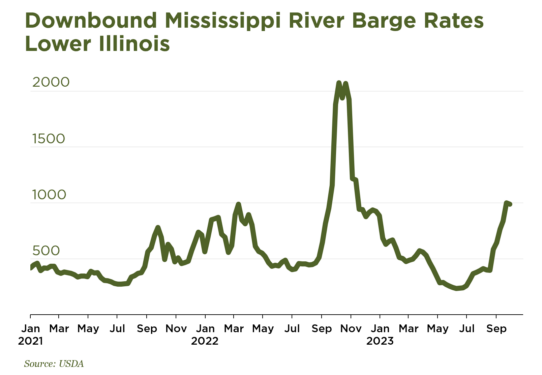Mississippi River water levels are near record lows
Low water levels threaten grain transportation
Last fall, this space was used to discuss low water levels in the Mississippi River, and history is now repeating itself. Due to a combination of drought, rising sea levels, sinking or settling land, and manmade changes to the river, water levels in the Mississippi are again near all-time lows in some areas. This has had a significant impact on shipping rates, although water levels are higher than a year ago. Additionally, there is renewed concern about the gulf of Mexico encroaching on drinking water in New Orleans.

- Water levels in the Mississippi are not rising but the decline has slowed as evidenced by the slower-than-expected pace of saltwater advancing toward New Orleans. The Army Corps of Engineers previously estimated that saltwater would pollute the water supply of New Orleans by mid-October, but an updated projection has pushed that arrival date back to late November. The slowdown is attributed to a combination of increasing the size of an existing underwater sill, flows in September beating prior projections, and an updated 28-day forecast suggesting more rainfall in October than previously expected.
- Low water levels have caused shipping rates to jump. The USDA Grain Transportation Report published in early October showed the index for barge rates stabilized in early October but was far higher than it was in late August. Still, its current level is roughly half what it was in October 2022.
- Load and tow size restrictions have been imposed by barge companies to prevent barges from getting stuck in low water, which has helped the flow of barges and kept shipping rates at a lower level. In fact, barge movement has improved in recent weeks.
- Additionally, low demand for grain exports has helped to keep rates from elevating as they did last year. Low water levels in the Mississippi River System (MRS) started to become a problem in June, but grain volumes on the MRS for the week ending July 8 were 53 percent lower than the five-year average.
- Although they have settled recently, there is upside risk to barge rates entering peak harvest season. If water levels remain at the current levels or worsen, increased MRS usage due to grain harvest could push rates up significantly. (AFBF)
Ag News Highlights
Hot weather causes spike in olive oil prices
Olive oil prices have surged, climbing more than 100 percent in 12 months as of August to levels not seen since the mid-1990s. Unusually hot weather combined with drought in the Mediterranean – especially Spain, the world’s largest olive producer – has devastated the olive crop in the region. Consequently, Spain’s olive oil production this season fell to roughly 610,000 tonnes, which is less than half of the typical 1.3-1.5 million tonnes. Italy and Greece, which rank second and third in the world in olive oil production, are having similar issues.
There are ample supplies of various other vegetable oils, but strict consumer and cultural preferences have prevented a significant amount of substitution, according to the USDA. Prices in the near term should remain high and cooler and wetter weather will be needed in the 2023/24 growing season to reduce prices back to normal. (Business Insider) (CNBC)
Spotted lanternfly still a concern
Major concerns about the growing spotted lanternfly population in Pennsylvania (i.e., killing off trees native to the area and disruptions agricultural crops) have not materialized, but the pest still poses a problem. According to Brian Walsh, an educator for Penn State Extension, they are destructive for grapes, and their current proximity to winery regions in southern New York is worrisome. Also, wine-producing countries from the European Union are concerned about the possibility of the insects being shipped accidentally with hardwoods from the eastern U.S. A ban from the EU on hardwoods from Pennsylvania could have a massive impact on the state’s economy.
The spotted lanternfly is native to China and has no natural predators in the U.S. The insect has been spotted in 14 states so far as the population spreads beyond the Pennsylvania borders. Current guidance calls for those who spot the pest to kill them if possible, and to report sightings to local ag extension organizations. (Sun Gazette)
Citations/Disclaimers
-
The information in this report is provided by Nationwide Economics and is general in nature and not intended as investment or economic advice, or a recommendation to buy or sell any security or adopt any investment strategy. Additionally, it does not take into account any specific investment objectives, tax and financial condition or particular needs of any specific person.
The economic and market forecasts reflect our opinion as of the date of this report and are subject to change without notice. These forecasts show a broad range of possible outcomes. Because they are subject to high levels of uncertainty, they will not reflect actual performance. We obtained certain information from sources deemed reliable, but we do not guarantee its accuracy, completeness or fairness.

